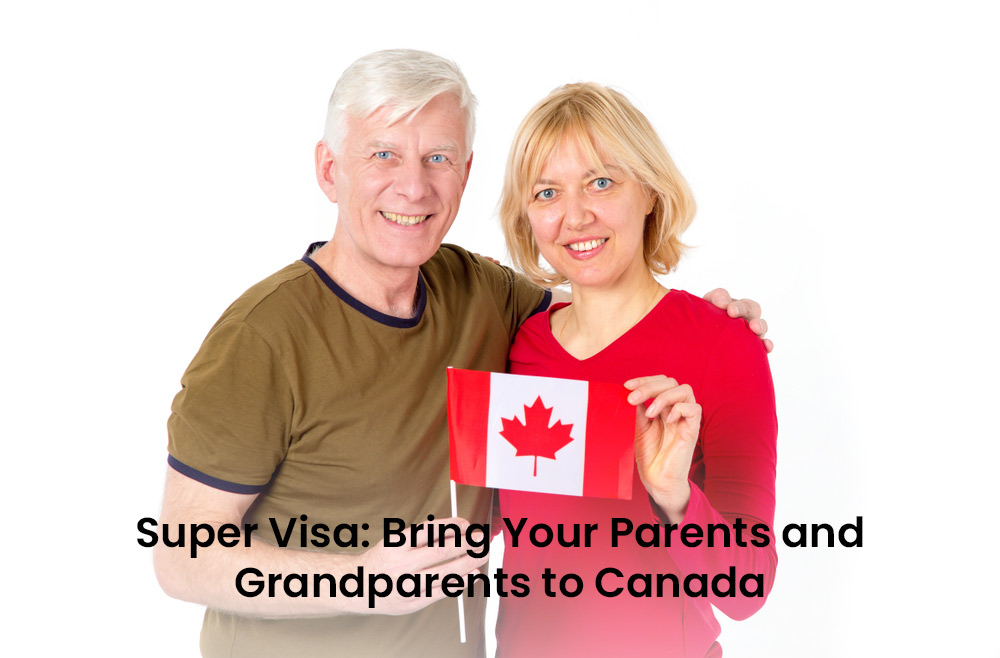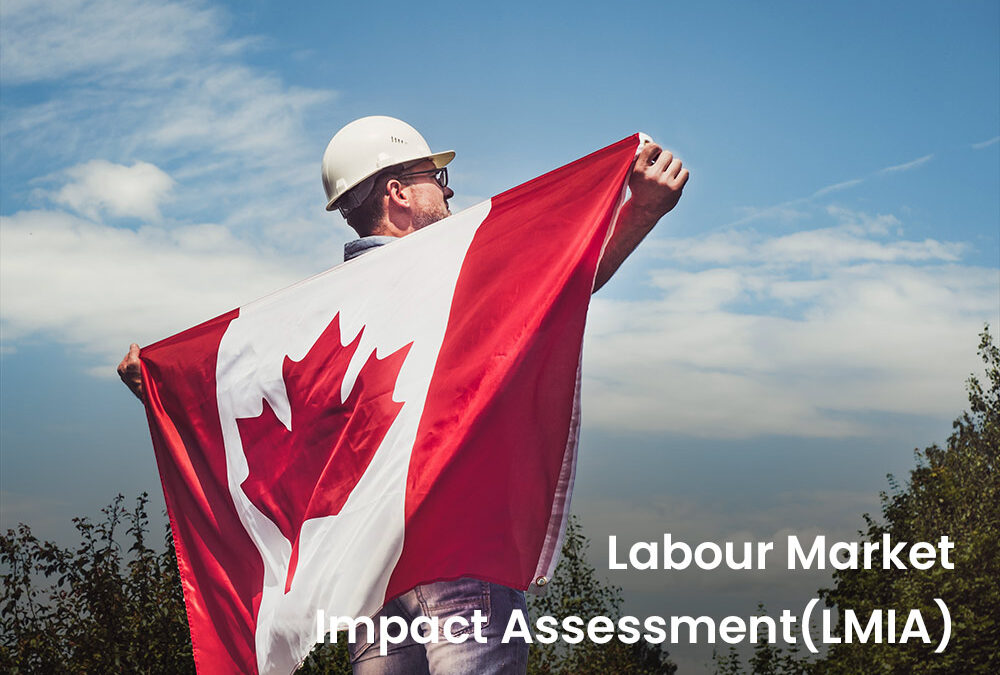
by Immilaw Team | Jan 5, 2023 | Canada Immigration
What is A super Visa?
The Super Visa enables parents and grandparents of Canadian citizens and permanent residents to enter the country as guests for up to five years (starting on July 4, 2022) without needing to reapply for their status.
Super Visa
Grandparents and parents are allowed to reside in Canada for a long time. Those who possess a Super Visa may seek an extension, which might enable them to stay in Canada as a tourist for up to 7 years. The Super Visa permits parents and grandparents to enter Canada several times for up to 10 years.
Free Immigration Assessment
Eligibility Criteria
To be eligible for a super visa, the necessary conditions are:
You must be-
- Be the parents or grandparents of Canadian citizens or permanent residents
- Possess a letter showing the intent to invite you to visit Canada, signed by your child or grandchild, that says the following:
(a) Consists of a guarantee of financial assistance for the period of your visit
(b ) Contains a concise list of the persons living in this person’s home
- There must be a copy of that person’s citizenship or permanent residency card.
- Contains the health coverage provided by a Canadian insurance provider that is:
- At least $100,000 in emergency coverage is sufficient for at least a year after admission.
- Possess a document showing that the medical insurance is fully paid.
Financial Proofs Required
The child or grandchild inviting you must provide evidence that their home earns at least the required amount of money. Examples of documents that can be used as proof of finances include the:
- A T4/T1 for the current tax year or a Notice of Assessment (NOA).
- Statements on Employment Insurance Benefits
- Employment letter including salary, job title, job description, date of hiring, and payment statements.
- Bank statements
The Applicant is Required To Apply For The Super Visa
- From outside of Canada
- Have your visa printed
- Take a medical examination for immigration (forms and instructions issued by the visa office after the application has been submitted).
- Dependents are not authorized on this application.
Who Can Apply for a Super Visa?
Parents or grandparents of Canadian citizens and permanent residents can apply for the Super Visa. On a Super Visa application, only parents or grandparents may be listed, along with their spouses or common-law partners.
Canadian Immigration
Super Visa Application Process
The application process is similar to that for a Temporary Resident Visa. There is a need for additional documentation to ensure that they will be taken care of during their stay in Canada. The Canadian visa office in charge of the applicant’s place of residence outside Canada is where the application should be processed. Necessary conditions-
- A letter of invitation from the grandchild or child living in Canada;
- Document demonstrating that the grandchild or child meets the LICO minimum income requirement
- Evidence of parental relationships, such as a birth certificate designating the person as a parent;
- Evidence of medical insurance coverage with a Canadian insurance provider for at least a year.
Factors are taken into account while the parent’s or grandparents’ application is being processed-
- They must be actual visitors to Canada who intend to depart on their own after the tenure for stay is over
- Ties with the country of origin
- The reason for the trip, the family’s wealth, and the overall political and economic stability of the native nation of origin
- Analyze the documents provided
For support and assistance in obtaining a super visa, you can contact Immilaw Immigration Law Professional Corporation. The lawyer’s vision, knowledge, and expertise strengthen you to achieve the desired goal smoothly and systematically.
We can be reached at info@immilawimmigration.com

by Immilaw Team | Oct 17, 2022 | Canada Immigration
What is AIP?
AIP enables immigrants who have been offered jobs to apply for permanent residence in Canada while working in the Atlantic area. Early in 2022, AIP became a permanent program due to its success. Since its implementation, the Atlantic provinces have been able to meet immigration limits more easily under the AIP, taking in roughly 6,000 immigrants annually.
Free Immigration Assessment
The Atlantic Immigration Program hopes to boost economic development in Canada’s Atlantic provinces by luring qualified workers. New Brunswick, Newfoundland and Labrador, Nova Scotia, and Prince Edward Island are the Atlantic provinces. Applicants should have an official job offer to be eligible for the Atlantic Immigration Program. In addition, the candidate must get a Labour Market Impact Assessment to receive a Canadian employment offer acceptable for immigration purposes (LMIA). However, for the Atlantic Immigration Program, this is not necessary. Instead, the employer that makes the job offer must be listed.
Beginning in 2017, the Atlantic Immigration Program was an experimental project that was later made permanent. As a result, over 6,000 people were welcomed to the Atlantic provinces annually, thanks to the AIP.
Are you eligible?
A job offer from a designated individual under the program is required for a skilled worker to qualify for AIP. When an employer submits an AIPP application, they are designated. You must also complete additional evaluation requirements for education, job experience, and language ability, which vary depending on the AIP stream you apply through.
How may one receive a job offer?
You must apply for employment with Atlantic Canadian companies that AIP has identified to be considered for a job offer. Below is a list of companies from each province permitted to use the AIP to hire foreign workers. Be aware that some Atlantic provinces have not yet made the most recent list of authorized employers available because the program just reopened.
Atlantic Immigration Program Requirement
The Atlantic Immigration Program facilitates immigration by connecting two parties:
1. Foreign nationals interested in becoming residents of Atlantic Canada
2. Employers designated by the government to hire foreign nationals/ International citizens seeking to settle in Atlantic Canada companies that the government has authorized to employ foreign nationals.
Atlantic Immigration Program has different requirements for each of these parties.
Need of Foreign Nationals
Only foreign nationals who meet specified qualifications may apply through the Atlantic Immigration program for immigration to New Brunswick, Newfoundland & Labrador, Nova Scotia, or Prince Edward Island. In addition, the foreign national must initially obtain a formal job offer from an authorized employer.
The Atlantic provinces include New foundland and Labrador, New Brunswick, Nova Scotia, and Prince Edward Island.
The foreign national must also fulfill the prerequisites to qualify. Whether the individual has finished the necessary postsecondary education in Atlantic Canada will determine which requirements apply.
Work Experience Requirement
Candidates must have at least one year of recent full-time, paid work experience. You may include hours worked outside of Canada based on a valid status. The job experience has to be at least at level 0 of the National Occupational Classification (NOC) or level A, B, or C.
Requirements for International Graduates
Candidates qualifying as overseas graduates are exempt from the criteria for job experience. However, candidates must fulfill the following criteria to qualify as an international graduate:
Possess a two-year minimum degree, diploma, certificate, trade certification, or apprenticeship certificate from an accredited postsecondary institution in one of the Atlantic provinces;
- Have completed their courses while enrolled full-time
- Have spent the two years before graduation spending at least 16 months living in an Atlantic province
- Have maintained the necessary job authorization/study authorization during their studies in Canada
- Have held the required study permit, and if required, work permit, during their studies in Canada
Educational Requirement
Different educational requirements will apply depending on the type of occupational skill required for the job offer. For information on the necessary education by skill type, please see the chart below:
Skill Type 0; the Lowest level of education- minimum of one year of postsecondary education (Canadian or equivalent),
Skill Type A; the lowest level of education- minimum of one year of postsecondary education (Canadian or equivalent),
Skill Type B; Lowest level of education- High school diploma as a minimum (Canadian or equivalent)
Skill Type C; the Lowest level of education- High school diploma as a minimum (Canadian or equivalent)
You must submit an Educational Credential Assessment to receive your education outside of Canada
Language prerequisites
The required Canadian Language Benchmark (CLB) level varies depending on the job’s skill requirements. For a breakdown of language requirements by skill type, please see the chart below:
Skill Type 0; CLB level 5
Skill Type A; CLB level 5
Skill Type B; CLB level 5
Skill Type C; CLB level 4
Proof of Funds
Additionally, candidates should be able to show they will have enough money to maintain themselves and their families after they move to Canada.
Needs for Designated Employers
Employers wishing to participate in the Atlantic Immigration Pilot Program must apply to be recognized as employers. A company can engage foreign nationals as designated employers without conducting a Labour Market Impact Assessment (LMIA). However, employees hired in the pilot program must get assistance from designated employers in relocating to their province of residence.
Organization Designation
An employer must first apply to be formally recognized before hiring foreign nationals through the Atlantic Immigration Program. The province where the company that wants to hire foreign nationals is located is where the employer can apply to become designated. The employer must show that all provincial regulatory agencies are in good standing. They must also provide a summary of their labour requirements, including the justification for hiring foreign workers.
Finally, selected employers must show that they can assist immigrants hired through the Atlantic Immigration Program with settling down. Businesses can look up applications to become designated employers on the websites for immigration in the Atlantic provinces: New Brunswick, Newfoundland and Labrador, Nova Scotia, and Prince Edward Island.
Events for New Brunswick Recruitment
New Brunswick frequently arranges international gatherings for foreigners looking to move to Canada. Please look at our list of future job fairs and information sessions in New Brunswick. Those successful in these information sessions will be qualified to immigrate to Canada via the Atlantic Immigration Program or the PNP for New Brunswick.
Once the Job offer is received, further process is required
Applicants will be allowed to move forward with the further steps once they have received an employment offer from a specific Atlantic employer. This will involve working with your business during the endorsement phase and developing a settlement package that details the individualized settlement services the applicant will receive once they arrive in Canada.
If the province concurs, the individual will be nominated and eligible to submit a federal application for permanent residence in Canada. They will also be permitted to start working in Canada with a work permit while they wait for their application to be processed.

by Immilaw Team | Sep 23, 2022 | Canada Immigration
What is Labour Market Assessment?
Canada runs the Temporary Foreign Worker Program (TFWP) as a method to supplement its workforce when there is no qualified worker in Canada to do a job. To hire a foreign worker in Canada, a company must apply for a Labour Market Impact Assessment (LMIA) from the Canadian government. Whenever a foreign worker is hired, the Canadian government employee assessing the application must decide if it will improve or have no impact on the Canadian labour market. Canada’s Employment and Social Development will examine the application (ESDC). The foreign worker must receive pay and benefits with federal and provincial norms, and it must be evident that no qualified Canadians must be given preference over him. Depending on whether the targeted person is a “high-wage” or “low-wage” employee, the LMIA procedure varies. Low-pay temporary foreign employees are those paid less than the provincial or territorial median wage; high-wage workers are those paid at or above the median wages.
LMIA Work Permit
Hiring a High-Wage Worker
You need to submit transition plans with the LMIA if you want to hire a high-wage worker. A transition plan is a plan that ensures you are taking the steps as an employer to reduce your reliance on foreign workers over time.
Transition plans are intended to ensure that employers looking for foreign employees are fulfilling the program’s objectives, i.e., utilizing it only as a last alternative for temporarily covering labour shortages when no qualified Canadians are available. By doing this, eligible Canadians are given preference for open positions. An employer can demonstrate this, for instance, by providing evidence of investment in skill development or support.
Free Immigration Assessment
Hiring a Low-Wage Worker
There is no requirement to submit transition plans with a Labour Market Impact Assessment (LMIA) application from employers looking to hire low-wage workers. But they must adhere to a distinct set of rules.
The Canadian government has restricted the number of low-wage temporary foreign employees that a company can hire to guarantee that Canadians may be given preference for open positions under the Temporary Foreign Worker Program (TFWP). Additionally, processing of the LMIA is generally denied for some low-wage jobs. The percentage of low-wage temporary foreign workers working for an employer having ten or more employees may not exceed 20% of their total workforce.
Employers who offer wages below the provincial/territorial median are required to:
- Pay for the temporary foreign worker’s round-trip transportation;
- Make sure there is access to affordable housing;
- Until employees are qualified for provincial health care, pay for private health insurance;
- The provincial or territorial workplace safety board should receive temporary foreign worker’s registration
- A contract between the employer and the employee.
Global Talent Stream
Certain talented employees can apply for a work permit through the Global Talent Stream and receive one two weeks later. It is a cornerstone of Canada’s Global Skills Strategy, which aims to support the expansion of innovative businesses by ensuring access to the highly qualified individuals they require.
This workstream creates a two-week norm for processing applications for work permits (and temporary resident visas, if necessary) for highly skilled talent, among other activities. Part of Canada’s Temporary Foreign Worker Program is the Global Talent Stream. The Global Talent Stream aims to help employers in Canada fast-track the hiring of foreign tech talent.
The Global Talent Stream has two categories. High-growth businesses falling under category A need to bring in foreign talent with specific skills. This category of employers requires a designated referral partner to refer them to the Global Talent Stream. Employers trying to fill positions on the Global Talent Occupations List—a list of professions for which there is a shortage of domestic labour—are in Category B. These positions are generally in demand.
Employers in both groups must adhere to the payment standards for skilled workers, which means they must pay their staff at least the going rate. The prevailing pay is the higher of the following two figures:
According to the Government of Canada’s Job Bank, the occupation’s median salary
- The pay range that a company now offers to current employees in the same role, working in the same location, and possessing the same qualifications.
- The Global Talent Occupations List’s minimum wage ceiling (if applicable).
Facilitated Labour Market Impact Assessment (LMIA)
Impact Assessment (LMIA) processing is updated annually by the Quebec Immigration Ministry.
By enabling them to engage foreign workers more rapidly, this procedure intends to assist Quebec firms in addressing their state’s well-documented labour shortages. Employers in Quebec do not have to provide evidence that they could not find a worker in Canada to fill the position because there is evidence of a labour shortage in these professions.
The following is required to be proven by the employer:
That the temporary foreign worker satisfies the job’s educational and experience prerequisites as well as those set forth by the National Occupational Classification; That the hourly wage offered to temporary foreign workers is competitive with that received by Canadians and permanent residents who work in the same profession and region.
All applications for high-wage LMIA must include a transition strategy. According to the facilitated process in Quebec, the transition plan is only necessary for a second or subsequent application for an LMIA in the same occupation and area.
Contact Us

by Immilaw Team | Sep 21, 2022 | Canada Immigration
Many temporary and permanent options attract global tech talent to Canada.
The tech industry in Canada is expanding rapidly, and it is anticipated that this trend will continue even as the number of qualified tech professionals in the country’s labour force declines. This expansion results from small enterprises and major corporations, like Google and Amazon, investing more money and expanding their operations in Canada. There are approximately 250,000 IT workers in Toronto alone due to this investment, which is a crucial component of Canada’s economy.
Free Immigration Assessment
The federal and provincial governments provide numerous options for permanent residence and work permits to help employers acquire individuals from outside due to the growing demand for talented tech experts. This article will outline several popular possibilities if you’re a tech employer or employee.
Temporary Work Permits
There are several temporary work permit options available to employers who are thinking about recruiting international talent. These initiatives are designed to enable employers to quickly hire the digital expertise they need for their businesses when there is a lack of qualified Canadian tech professionals.
The Global Talent Stream
In the technology industry, one popular solution is the Global Talent Stream (GTS). It seeks to attain a processing standard of two weeks once the prospective employee submits the final application, and this was developed to support the expansion of Canada’s IT sector. This route also serves as a temporary work visa and a stepping stone for workers who want to qualify for permanent residency.
It is regarded as a component of the Temporary Foreign Worker Program (TFWP), and to be qualified, businesses must first receive from Employment and Social Development Canada (ESDC) a neutral or favourable Labour Market Impact Assessment (LMIA). In addition, when employing workers from outside, ESDC assesses whether this will have a positive, neutral, or adverse effect on the labour market in Canada.
Additionally, employers must fulfil the requirements in one of the following two categories to be eligible to hire under this programme:
Category A
Companies who contact EDSC through a referral partner fall under Category A. Governmental, local, or government-affiliated organizations or companies that have the mandate to help local economies are frequently referred to as referral partners. The workers hired in this group have a deep level of expertise in a particular area of the tech industry. Employers must submit applications under category B if the candidate’s profession is already listed on the Global Talent Occupations List.
Category B
Employers who need workers in professions already on the list of Global Talent Occupations, such as software engineers, designers, or information systems analysts, fall under category B. The government has acknowledged the scarcity of these abilities in the Canadian labour force for these in-demand professions.
Labour Market Benefit Plan
Employers must also submit a Labour Market Benefits Plan (LMBP) to EDSC outlining their commitment to long-term labour market benefits. Depending on the category, the focus varies. In addition, a strategy outlining how recruiting under the GTS would create more jobs for Canadians and permanent residents are required.
Category B LMBPs must demonstrate how they will increase their spending on educating Canadians and permanent residents in high-demand tech skills.
There are restrictions on how skilled workers are compensated in both categories. Anyone hired via the Global Talent Stream must be compensated at least at the prevailing salary.
The highest of the following is the prevailing wage:
- The minimal salary floor as specified in the Global Talent occupations list;
- The wage that a company pays current employees in the same role at the same location, with the same skills and experience;
- The median wage for the occupation listed on the Government of Canada Job Bank (if applicable).
CUSMA
An employer may qualify for the Canada, United States, and Mexico Agreement if they employ tech talent elsewhere in North America (CUSMA). It is a temporary work permit, just like the GTS.
This agreement may facilitate talent exchange between nations. Therefore, the agreement is additionally divided into two groups that apply to IT personnel.
Professionals: The professional category includes 63 professions that are eligible for CUSMA. Software developers and other well-known tech professionals like systems analysts may be qualified.
Intra-Company Transfers (ICTs): Employees of international corporations relocate to the company’s Canadian office in a process known as an intra-company transfer (ICT). The transferee frequently has a management job or possesses other advanced skills.
International businesses that qualify for ICTs don’t always have to be based in Mexico or the US. Employees from other countries may be able to transfer to Canada if any organization has a formed branch there without the need for the employer to obtain an LMIA.
Pathways to Permanent Residency in Canada
Tech talent might want to settle permanently in Canada. A Provincial Nominee Program or an immigration programme that is part of the Express Entry application management system is the most typical route for skilled tech workers to seek permanent residency (PNP).
Express Entry
Express Entry is the most significant entry stream for skilled immigrants in Canada. Candidates with technical backgrounds are more likely to be invited to apply for permanent residence under Express Entry.
Express Entry aims to speed up the application process for skilled workers. The Federal Skilled Worker Program is the most well-liked Express Entry choice (FSWP). The National Occupational Codes 0, A, or B, which cover most jobs in the tech sector, are required for people with at least one year of work experience in this programme.
Alternative options include the Canadian Experience Class (CEC) programme, which may make applicants eligible for Express Entry if they have one year of work experience in Canada over the previous three years. Alternative options include the Canadian Experience Class (CEC) programme, which may make applicants eligible for Express Entry if they have one year of work experience in Canada over the previous three years.
Express Entry involves two steps:
Candidates must determine if they qualify for the programme they desire to apply to. If qualified, they must submit a profile to the Immigration, Refugees and Citizenship Canada (IRCC) website. Based on their profile’s other human capital elements, including their education, work experience, and language skills, IRCC will award a Comprehensive Ranking System (CRS) score. The score increases the likelihood of receiving an invitation to apply (ITA) for permanent residence.
IRCC holds draws every two weeks or such. After receiving an ITA, candidates have 60 days to submit their complete application to IRCC.
Provincial nomination tech talent streams
Over 100 economic immigration routes are available in Canada, many of which are a component of the Provincial Nominee Program (PNP). Except for Quebec and Nunavut, every province in Canada has a PNP that cooperates with the IRCC. Through these initiatives, provincial governments can choose applicants they think will fit well in their jurisdictions. In addition, there are immigration programs in several Canadian provinces intended to draw IT expertise.
Provincial tech talent streams are provided below:
Candidates for the BC Tech Stream must be qualified for one of the province’s immigration schemes and have an employment offer which holds good for at least a year.
OINP Tech Draw: Applicants must be qualified for either the Federal Skilled Worker Program or the Canadian Experience Class to participate in this Ontario Immigrant Nominee Program.
Saskatchewan Tech Talent Pathway
Approved candidates must have an employer-specific Saskatchewan Immigrant Nominee Program (SINP) Job Approval Letter for an eligible technology sector position. They need at least one year of work experience in that occupation during the preceding five years.
Alberta Accelerated Tech Pathway
Candidates for the Alberta Accelerated Tech Pathway must be eligible for the Alberta Express Entry Stream. In addition, they must either have a job offer in one of the 23 eligible occupations or be employed in Alberta.
Quebec
The Quebec Immigration Program for Workers in the Artificial Intelligence, Information Technology, and Visual Effects Sectors is a unique program that Quebec offers.
Under this program, there are two areas for technology:
AI (Artificial Intelligence)
There are two ways to qualify for the AI (Artificial Intelligence) stream. A candidate must have work experience and a job offer if they attended a college or university in Quebec. If the candidate received their training abroad, they might not need a job offer, but they must show proof of education at par with a bachelor’s degree from Quebec.
IT and Visual Effects streams
Candidates for the IT and visual effects programs must have two years of work experience in one of the ten approved professions over the previous five years. They must also have a work offer in that industry and the academic standing of a bachelor’s degree or the equivalent of a Quebec technical studies certification.
Feel free to contact us for your queries.

by Immilaw Team | Sep 15, 2022 | Canada Immigration
Three years at least out of the last five years, is the simple answer, but there are slight changes to that.
At least for 1,095 days or three out of the five years, you need to be physically present in Canada before applying for citizenship to become a Canadian citizen. However, not all days are equal regarding eligibility for Canadian citizenship. For example, only if you were physically present as a permanent resident in Canada Immigration Refugees and Citizenship Canada (IRCC) will you count it as full days for meeting the physical presence requirement criteria.
Free Immigration Assessment
Up to a maximum of 1 year or 365 days, every day you spend in Canada as a Temporary Resident (TR) will only be counted as a half day. So, it will take two years to reach the required maximum number of days as every day is counted only as a half day. You don’t need to spend time in the country to get citizenship. But being a TR, you will be able to know how well to calculate and meet your physical presence requirement.
Read along to find a few hypothetical scenarios showing how the physical presence calculation works.
- Alice worked in Canada for three years on a Post-Graduation Work Permit (PGWP) before getting her Permanent Resident (PR) status. She applied for her citizenship two years after becoming a PR. Her two years in Canada on the PGWP were counted as one year by IRCC for her physical residency requirement. The two years she spent in the country as a PR were then added for three years towards eligibility for her citizenship.
- Through Federal Skilled Worker Program (FSWP), Rakesh got approved for his PR from outside Canada. He decided to apply for citizenship after living in Canada for three years. Each day he physically spent in the country was counted as a full day by IRCC as he was not a TR while living in Canada.
- Emma was employed in Detroit, USA when she got her Canada PR through FSWP. Emma then relocated to Windsor, Canada, and traveled daily to the US to work. This routine continued for five years before Emma applied for her Canadian citizenship. Emma traveled to the US, returned to her home in Canada every day, and got counted as a full day by IRCC. It was because she had already spent more than the required days in Canada to meet the physical presence requirement.
On the official website, IRCC strongly recommends that you need to stay physically present in Canada for more than a minimum of 1,095 days before you apply for your citizenship to ensure eligibility.
Canadian Immigration
Other Eligibility Conditions For a Canadian Citizenship
There are a few more eligibility conditions for obtaining Canadian citizenship other than the physical presence requirement in the country.
- To communicate effectively in Canadian society, you must speak English or French. You need to submit proof of language proficiency if you are between the age of 18 and 54.
- IRCC has decided not to grant citizenship to people with a criminal history.
- You need to know about the rights and responsibilities of the citizens and possess a basic knowledge of Canada’s history, geography, and political system.
- You will have to file your taxes in the country for a minimum of three years during the five years before the date of your citizenship application.
- You must pay the right of citizenship and government processing fees when submitting a formal application to IRCC.
- You can apply for your citizenship once you meet all the eligibility requirements. Applicants between the age of 18 and 54 are required to take their citizenship test once they get approved.
Following that, they will have to attend the citizenship ceremony to receive the certificate of Canadian citizenship by taking the Oath of Citizenship. You will then officially become a Canadian Citizen after that.
Physical Presence Requirement For Pre-Removal Risk Assessment (PRRA) Applicants And Refugee Claimants
You would not get TR if your PRRA or refugee claim got assessed when you received a study or work permit. IRCC will not calculate this period towards your physical presence.
If you are claiming your time being a protected person, the only time that is permitted is the time from when you got a favorable decision regarding your claim or the PRRA application made until the day before you got your PR. The days you have spent in the country after the approval and before getting your PR will only be counted as half a day towards applying for citizenship.
If You Were a Prisoner in Canada
If you have spent any time being a prisoner in Canada or were on parole or probation, those days will not get counted toward your physical presence criteria. You can see some exceptions to this, though. First, the time spent on probation due to a conditional discharge may account for your physical presence if you do not breach parole. You don’t have to declare your time spent on probation or prison if you have received a youth sentence and completed that sentence without fault. Finally, suppose your time served as a punishment for committing an offense in the country happened five years before the date of your application; that time is outside the period considered for your physical presence by IRCC.
Feel free to contact us for your queries.

by Immilaw Team | Sep 13, 2022 | Canada Immigration
Get ready to enjoy Canadian permanent residence status in six months or less through the Express Entry program!
The department of Immigration Refugees and Citizenship Canada (IRCC) has massive immigration plans for 2022-2024. Canada uses the Express Entry program mainly for managing the applications for permanent residence status for their Federal Skilled Worker Program (FSWP) Program, Federal Skilled Trades Program (FSTP), and the Canadian Experience Class (CEC) immigration program.
Free Immigration Assessment
Immigration minister Sean Fraser recently stated that the department of IRCC has concrete plans to pursue more immigration pathways for strengthening Canada’s speedy economic recovery from the Covid-19 pandemic. The country now strives to address the serious labour shortage crisis, support the country’s diversity, and build communities for a better future. The country is aiming to welcome 360,000 to 445,000 fresh permanent residents in 2022, 380,000 to 465,000 in 2023 and 390,000 to 475,000 by 2024. Read along to know more about receiving your permanent residence status in just six months or even less than that.
Canada Immigration
How to apply for Express Entry
Immigrants interested in the Express Entry pathway should have a minimum of one year of continuously paid work experience to apply for their Canadian permanent residency status. The primary application process is unbiased and based on a point ranking system. Once you get 67+ points, you are eligible to enter the pool from which the next steps follow. The points are based on age, work experience, English or French fluency, education, and Comprehensive Ranking System (CRS) scores. In this pool, you get access to the board for job positions in Canada. For this pool, too, your ranking will be calculated based on the points you get. You may update your profile at any time of the year to show your educational attainment or if you wish to add other needful updates to your application to increase the point score.
Express Entry
Once you attain the required point score, you will be more chances to get selected during a drawing. Henceforth, with additional paperwork, you may proceed to become a permanent citizen. Once your permanent resident status is approved, you must live in the country for a minimum of 2 years out of the next five years.
Economic immigration
Canada’s government now recognizes the significant need for increased immigration pathways to grow the labor force and the economy. It can be attained only by bringing in more qualified people with the right skill sets to meet the country’s present and future economic needs. The Express Entry system supports the increased proportion of skilled immigrants from around the globe to complement the ongoing immigration efforts. Canada is also making adequate efforts to retain the talent already present in the country. For this, the applications of over 90,000 temporary workers from the health/essential sectors and the student graduates who have applied for the May to November 2021 Permanent Residence to Temporary immigration pathways will get finalized. In addition, the government announced the Economic Mobility Pathways Pilot (EMPP) for skilled refugees to easily access other economic immigration pathways such as the Provincial Nominee Program (PNP), and Atlantic Immigration Program (AIP), and the Rural and Northern Immigration Pilot (RNIP) Program.
Provincial Nominee Program
Feel free to contact us for your queries.







